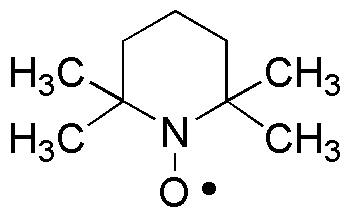2,2,6,6-Tetramethyl-1-piperidinyloxy, free radical is widely utilized in research focused on:
- Antioxidant Studies: This compound serves as a stable free radical, making it an excellent model for studying antioxidant mechanisms in biological systems. Researchers can explore how it interacts with other radicals and its potential protective effects against oxidative stress.
- Polymer Chemistry: It is used as a radical initiator in polymerization processes, particularly in the production of thermoplastic elastomers. Its stability allows for controlled polymer growth, leading to materials with desirable properties.
- Medicinal Chemistry: The compound is investigated for its potential in drug development, particularly in creating novel therapeutic agents that target oxidative stress-related diseases, such as neurodegenerative disorders.
- Material Science: It finds applications in the formulation of advanced materials, including coatings and adhesives, where its radical properties can enhance durability and performance.
- Food Preservation: Researchers explore its use in food science as a natural preservative, leveraging its antioxidant properties to extend shelf life and maintain food quality.
General Information
Properties
Safety and Regulations
Applications
2,2,6,6-Tetramethyl-1-piperidinyloxy, free radical is widely utilized in research focused on:
- Antioxidant Studies: This compound serves as a stable free radical, making it an excellent model for studying antioxidant mechanisms in biological systems. Researchers can explore how it interacts with other radicals and its potential protective effects against oxidative stress.
- Polymer Chemistry: It is used as a radical initiator in polymerization processes, particularly in the production of thermoplastic elastomers. Its stability allows for controlled polymer growth, leading to materials with desirable properties.
- Medicinal Chemistry: The compound is investigated for its potential in drug development, particularly in creating novel therapeutic agents that target oxidative stress-related diseases, such as neurodegenerative disorders.
- Material Science: It finds applications in the formulation of advanced materials, including coatings and adhesives, where its radical properties can enhance durability and performance.
- Food Preservation: Researchers explore its use in food science as a natural preservative, leveraging its antioxidant properties to extend shelf life and maintain food quality.
Documents
Safety Data Sheets (SDS)
The SDS provides comprehensive safety information on handling, storage, and disposal of the product.
Product Specification (PS)
The PS provides a comprehensive breakdown of the product’s properties, including chemical composition, physical state, purity, and storage requirements. It also details acceptable quality ranges and the product's intended applications.
Certificates of Analysis (COA)
Search for Certificates of Analysis (COA) by entering the products Lot Number. Lot and Batch Numbers can be found on a product’s label following the words ‘Lot’ or ‘Batch’.
*Catalog Number
*Lot Number
Certificates Of Origin (COO)
This COO confirms the country where the product was manufactured, and also details the materials and components used in it and whether it is derived from natural, synthetic, or other specific sources. This certificate may be required for customs, trade, and regulatory compliance.
*Catalog Number
*Lot Number
Safety Data Sheets (SDS)
The SDS provides comprehensive safety information on handling, storage, and disposal of the product.
DownloadProduct Specification (PS)
The PS provides a comprehensive breakdown of the product’s properties, including chemical composition, physical state, purity, and storage requirements. It also details acceptable quality ranges and the product's intended applications.
DownloadCertificates of Analysis (COA)
Search for Certificates of Analysis (COA) by entering the products Lot Number. Lot and Batch Numbers can be found on a product’s label following the words ‘Lot’ or ‘Batch’.
*Catalog Number
*Lot Number
Certificates Of Origin (COO)
This COO confirms the country where the product was manufactured, and also details the materials and components used in it and whether it is derived from natural, synthetic, or other specific sources. This certificate may be required for customs, trade, and regulatory compliance.


